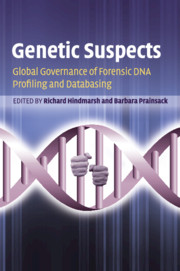Book contents
- Frontmatter
- Contents
- List of contributors
- About the contributors
- Foreword
- Acknowledgements
- 1 Introducing Genetic Suspects
- Section 1 Key areas in DNA profiling and databasing
- 2 Key issues in DNA profiling and databasing: implications for governance
- 3 Forensic utilization of voluntarily collected DNA samples: law enforcement versus human rights
- 4 Base assumptions? Racial aspects of US DNA forensics
- 5 Health and wealth, law and order: banking DNA against disease and crime
- 6 DNA profiling versus fingerprint evidence: more of the same?
- Section 2 National contexts of forensic DNA technologies and key issues
- Section 3 Conclusions
- Index
- References
2 - Key issues in DNA profiling and databasing: implications for governance
from Section 1 - Key areas in DNA profiling and databasing
Published online by Cambridge University Press: 05 October 2012
- Frontmatter
- Contents
- List of contributors
- About the contributors
- Foreword
- Acknowledgements
- 1 Introducing Genetic Suspects
- Section 1 Key areas in DNA profiling and databasing
- 2 Key issues in DNA profiling and databasing: implications for governance
- 3 Forensic utilization of voluntarily collected DNA samples: law enforcement versus human rights
- 4 Base assumptions? Racial aspects of US DNA forensics
- 5 Health and wealth, law and order: banking DNA against disease and crime
- 6 DNA profiling versus fingerprint evidence: more of the same?
- Section 2 National contexts of forensic DNA technologies and key issues
- Section 3 Conclusions
- Index
- References
Summary
INTRODUCTION
On 4 December 2008, the European Court of Human Rights (ECHR) delivered its Grand Chamber Judgment in the case of S and Marper v. the United Kingdom (2008). The judgment dealt a major blow to the national forensic DNA database (United Kingdom National DNA Database (NDNAD)) in England and Wales, the largest forensic DNA database in Europe. That judgment informs the purpose of this chapter, which is to review key issues of DNA profiling and databasing, many of which contribute to contesting forensic DNA technologies as an infallible means to truth finding in the criminal justice system (e.g. Lynch et al. 2008). The chapter concludes with a discussion of the implications that these issues have for the governance of DNA forensic profiling and databasing.
The case of S and Marper v. the United Kingdom (2008) was brought to the ECHR by Michael Marper and another young man known only as ‘S’, whose fingerprints and DNA profiles were stored in the English police database following their arrest in 2001. Charges had been dropped in both the case of Marper (arrested on harassment charges) and of S (at age 11 arrested for attempted robbery). In the absence of convictions, both men demanded their fingerprints and DNA data be removed from the database.
- Type
- Chapter
- Information
- Genetic SuspectsGlobal Governance of Forensic DNA Profiling and Databasing, pp. 15 - 39Publisher: Cambridge University PressPrint publication year: 2010
References
- 6
- Cited by



